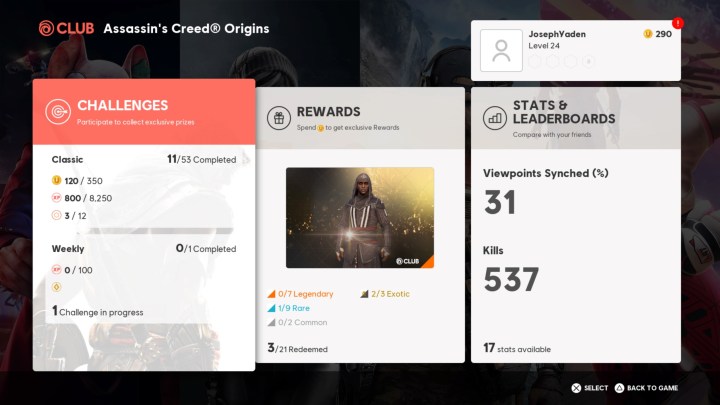With Assassin’s Creed Valhalla on the horizon, you might be considering jumping back into some of the series’s most beloved games. Entries in the series like Assassin’s Creed Origins have experienced a resurgence as of late, with many players revisiting the land of ancient Egypt. Origins plays much differently than older installments, dropping the simple stealth gameplay in favor of a much more challenging, robust RPG-action hybrid. However, just because the game is different doesn’t mean you won’t be able to master it! Here is what you need to know when you’re starting the game.
Approach each battle with caution

The first change you’re going to immediately notice in Assassin’s Creed Origins is its new combat system, as you’re thrown into a fight with basically no exposition at the beginning of the game. In previous games, you waited for enemies to attack and used a countering move to disarm them before going in for the kill. This is no longer the case. Instead, the new assassin Bayek has access to heavy and light attacks, a dodge, and a parrying move that is much more difficult to use than the counters and parries available in previous games. While the old “it’s like Dark Souls” line has been used constantly over the last few years, it’s the best reference point for Origins.
When you enter a fight, take note of how far away your enemy is, as well as any other targets who could soon join the fight. Distance is much more important in Origins than in past games, as you don’t zip over to the nearest target when you press the attack button. Likewise, if an enemy is in range and swings their weapon, it doesn’t matter if you’re in the middle of a dodge animation: You are getting hit. When you see an enemy about to attack, your best bet is to dodge behind them, as you’ll be able to get in a hit or two before the enemy can respond and you will do bonus back-stab damage … just like in Dark Souls. You’ll also want to keep your shield up at all times, unless you’re attacking. If you make this your default stance, it’ll save you the headache of taking lots of damage.
Another thing to consider is your damage multiplier. As you strike an enemy, your multiplier will go up by .10. This means you will do more damage if you consistently strike an enemy. Try to back them into a wall to wail on them over and over again for maximum damage.
Plan ahead
In past Assassin’s Creed games, there were a few different enemy types that required slightly different strategies in combat. There is far more variety in Assassin’s Creed Origins. Standard grunts are still a relatively simple affair — just dodge, block, and attack — but enemies who use shields must have their guard broken with a heavy attack before you’re able to strike them. Larger enemies with full-length shields need to be hit with a charged heavy attack first, an ability you unlock on the skill tree. Lastly, there’s another large enemy type that wields an enormous mace, which must be avoided at all costs.
You will recognize the weaknesses and strengths of each class over time, and you should always prepare before a fight to ensure you aren’t caught off-guard. Send your eagle Senu around enemy camps to mark enemies, and you’ll be able to spot the toughest guards before you actually enter the area. This is also a great opportunity to swap out your weapons — against multiple targets, fast swords and sickles aren’t going to cut it (literally), so you will want to have access to a large ax, mace, or scepter in your second weapon slot.
Stay on your grind

If you run into an enemy who is more than two or so levels higher than you, you will find yourself unable to make much of a dent. They will take you out without needing to call for backup. But even if you’ve reached parity with the enemies you’re facing, you still may encounter problems while trying to take out multiple soldiers if your grand plans blow up in your face. To prepare for the worst, consider pumping up your level a notch or two above the recommended level. You will find that targets go down much more quickly and you will be able to take a few extra hits before dying.
Killing enemies will earn you a small amount of experience, but the fastest way to boost your level is to complete side missions. If you’re level 15, try completing missions intended for as low as level 12, as the experience you earn for completing it will still be significant. In general, you should do as many side missions as you can before advancing the story, as several main quests feature multiple stages, with escalating level requirements. If the first part of the main quest suggests you get to level 16, for instance, it could be followed by another mission meant for players three or four levels higher. Going in “overprepared” is always a good idea.
Thin out big groups with your bow

Using the bow is crucial to success in tricky fights. There are four different types of bows — predator bows, warriors bows, hunter bows, and light bows. Each one is useful in a different scenario. We found the two stealthy options to be the best for a classic, stealthy playstyle. The hunter bow corresponds to a standard bow you find in many action games, with a medium-length draw time and enough power to take out most targets with a few shots to the head. The predator class is much quieter and can kill a standard enemy at your level in a single headshot.
The bow is particularly useful because stealth assassinations aren’t guaranteed kills in Origins. Against high-level targets, they will only take off a portion of their health. As a result, a well-placed shot from a predator bow is often a more efficient way to kickstart a fight. Just don’t fall into the trap of firing the bow once combat begins, as your peripheral vision is almost completely eliminated and you’ll be flanked by enemies you can’t see.
Go hunting and upgrade your gear

Hunting animals was largely optional in past Assassin’s Creed games, but it’s effectively mandatory in Origins. In addition to providing extra income when sold at shops, the leather you gather from animals can be used to upgrade your armor — giving you more health and melee damage — as well as the quiver for your bow. If you’re struggling to take down an enemy who is already at an appropriate level, try upgrading your armor a few times. It just might give you the edge you need.
You can also pay a blacksmith to upgrade your weapons and armor. If you have the money, a smith will be able to bring any weapon up to your current level, increasing its stats. While it’s useful, upgrading weapons gets very expensive quickly. Only use it when you find a particular weapon you enjoy using. Even then, don’t be afraid to let go of your gear when you find something more powerful. You’ll go broke if you upgrade your weapons too often.
Make the most of your environment
Your axes, swords, and maces offer you plenty of tools to take out the many enemies scattered across ancient Egypt, but Egypt itself can often give you the biggest advantage. When you enter an enemy camp, there will always be at least one brazier a short distance from the guards inside. Should you alert them to your presence, they will dart to the brazier and light it, calling a wave of reinforcements that are often too much for Bayek to handle on his own. If you reach the brazier before combat begins, you can set a trap that will explode when a guard attempts to light it. Make sure that you have accounted for all braziers in the area, though, as larger forts and camps often have a few spread out across the area.
You will also often spot deadly animals like lions trapped in cages, which you can use to your advantage. Just unlock the cage and reach higher ground. All enemies in the region will be distracted with their newfound lion problem, giving you the opportunity to collect a few kills before they take down the beast.
Climb the towers

You don’t technically need to climb the game’s many towers to unlock missions and vendor locations on your map, but you should do it anyway. Each tower you climb becomes a fast-travel point, and synchronizing with them improves Senu’s ability to detect points of interest. Given the size of the game, if you ignore the towers, you will find yourself spending a lot of time running and horseback riding. You’ll end up wasting more time than you would have spent climbing the towers in the first place.
As you synchronize with more towers, you increase the perception of your eagle, Senu, allowing the bird to spot targets from farther away and even see enemies behind walls. It can be quite difficult to see enemies with the naked eye, so this should lower the chances of Bayek being ambushed by an enemy he hadn’t seen when scouting earlier.
Clear out the map

It’s a Ubisoft game, after all. Make the most of this by clearing out the map before you progress through the story. Origins features a massive world with hundreds of things to do. Nearly everything you do earns you XP and you’ll be able to over-level your character by completing all the side tasks first. Open your map and pay attention to the points of interest scattered throughout the world.
You’ll find question marks, cities, forts, treasures, tombs, view points, and side missions to complete — of which will help you upgrade your character upon completion. Some side missions, like the ones that require you to kill a certain animal, will grant you various crafting gear, while others will reward you with money. Of course, you can speed through the story without exploring the map and clearing out the points of interest, but you’ll likely find it easier if you take the time to do all the small tasks first.
Experiment with Ubisoft Club rewards

During this generation, Ubisoft implemented Ubisoft Club rewards into most of its games, giving you an incentive for completing extra challenges. These include tasks you’d see in a typical PS4 trophy or Xbox One achievement. Completing Ubisoft Club challenges will grant you currency to spend on in-game goodies like weapons, extra missions, and costumes. In Origins, there are lots of different things to spend your units on, so be sure to check out the list from the pause menu. Don’t forget — you can upgrade the weapons you buy from Ubisoft Club to make them even stronger.
Editors' Recommendations
- The best Palworld tips and tricks for beginners
- All Lost Book locations in Assassin’s Creed Mirage
- The best skills to get in Assassin’s Creed Mirage
- Assassin’s Creed Mirage: release date, trailers, gameplay, and more
- Assassin’s Creed Mirage is coming out earlier than expected


